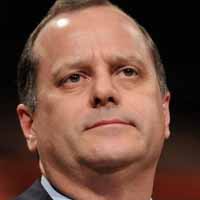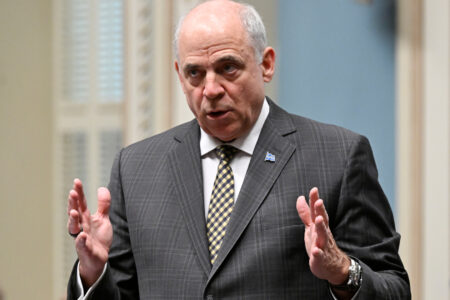
The Canadian economy faces many interesting challenges — the central one being, in my view, the unacceptable price being paid by all Canadians, including the wealthiest among us, of growing economic and social inequality. We are all paying the price on many fronts for this fundamental failing of our economy — income inequality on a scale we last saw in the late 1920s. We know what came after that. And what came after that.
There is much to say about this and much to be done about it. But in this article, I want to focus on three matters. First, I would like to review a little history and argue that Canada has followed Conservatives (red and blue) for too long down the road of breaking the fiscal capacity of the Government of Canada, and thus breaking its ability to address our fundamental economic challenges. It’s time to right the balance.
Second, I am going to suggest that Canada is inviting a great deal of economic trouble by ignoring its international responsibilities to address climate change. In so doing it is also missing an important economic opportunity to build an economy that is more prosperous, and in a better position to narrow income gaps and all the prices we are paying for those income gaps.
Third, I’d like to touch on the fundamental question of what kind of economy we’re trying to build: whether Canada should continue with the present Conservative government’s approach that raw resource exports should be the focus of our economy, or whether we should get on a better road. The future of our energy economy is a good example of what I mean, so I’ll refer to that sector to illustrate my case.
For the history, I worked for much of the 1990s as a senior official in the Government of Saskatchewan, a government that was led very competently by Premier Roy Romanow and then, equally competently, by Premier Lorne Calvert. When our government came to office, we were presented with a notably grim inheritance by our Conservative predecessors. The Conservatives had been elected to govern a province with a balanced budget and zero net public debt. To summarize much misgovernment, they cut taxes, they increased spending, and they argued that this would balance the budget, a familiar playbook. In 1991, after nine years in office, they handed us a $14.865-billion public debt, having run deficits every year they were in office.
Things were set to get worse. The province was running a $1-billion annual deficit, on little more than $4 billion in annual revenue. Investors and savers had lent an enormous sum of money to the province of Saskatchewan on the strength of its reputation for fiscal good management under a long string of NDP governments. By the time we replaced the Conservatives in office, that reputation had been thrown away, as measured by the province’s bond rating, which was about to slip from investment grade to BBB — a level at which most of the province’s pension funds would no longer invest in the province’s own bonds. When you reach that point in public finance, you learn what it means to be in office but not in power. The Conservatives had destroyed the government’s fiscal capacity and thus the sovereignty of its legislature. Bond raters had, arguably, a bigger say over the future of the public interest of citizens than their elected representatives — an intolerable destruction of responsible government.
In those circumstances, newly elected to office, we knew we had to act. We asked high-income individuals to help address this true fiscal crisis by contributing more, through a high-income surtax. We called on all citizens to help save the province through a series of other tax measures. And, not without tears, we addressed public spending. It worked. Over the course of our first term in office, we engineered a billion-dollar fiscal turnaround, taking the province from an absolutely unsustainable deficit to balanced budgets. The NDP government in Saskatchewan restored the province’s credit rating and its financial reputation.
And then, one practical step at a time, we got back to work on broader priorities, rooted in the principles and values of our party — priorities like addressing poverty, investing in education, making health care better and more efficient, and renewing the province’s infrastructure and competitiveness on many fronts. We didn’t get everything right during our four terms in office under Premiers Romanow and Calvert. But we did demonstrate a fundamental fact about the New Democratic Party in office: our party begins from the premise that strong public finances are one of the first principles of good government.
Even if that means taking on populist myths, like the one that broadbrush tax cuts are free, and that the resulting deficits will never be a problem.
The Government of Canada should step up as a partner to help provinces and energy companies get out of coal-fired electricity production, and to transition to future fuels — like natural gas (for a time), and then to sustainable sources like wind, solar, tidal and thermal energy.
Prime Minister Stephen Harper has not yet done as much damage to Canada’s public finances as his provincial cousins did in Saskatchewan. But the underlying logic of his fiscal policies is the same. Harper is another new-model “conservative” who believes you can cut taxes, increase spending and balance the budget. And in pursuit of this policy (which has worked so well all around the world, as we can see in Greece, in Ireland, in the United States and in many other countries!) he is spending a prodigious amount of money every year on tax expenditures.
In my view, much of this spending represents misplaced priorities — a waste of public funds that should be promptly ended, so that these funds can be more efficiently and productively invested in more important priorities. And there are indeed more important priorities, such as climate change, which is the second matter I would like to discuss.
Sooner or later — sooner, in an orderly manner, or later, in a disorderly crisis — we and the rest of the world are going to have to address climate change. Galileo was right — the world is round and circles around the sun. Darwin was right too — the world was created more than 6,000 years ago, and God’s creatures evolved over a very long period of time. And in substance all of the world’s credible climate scientists are right as well — carbon emissions are changing the world’s climate, and will do so increasingly disastrously unless we act to slow it. But here in Canada, instead of acting, we have already wasted more than 10 years talking. If we recklessly and irresponsibly put off the inevitable, as the Harper government clearly seems determined to do, we’ll end up having to take abrupt, last minute and drastic steps — just as we had to do in Saskatchewan to deal with fiscal recklessness and irresponsibility.
According to the Conference Board of Canada, today Canada produces 75 percent more waste than it did in 1980. On a per capita basis, Canadians use eight times more water than people living in Denmark. And Canada ranks 15th out of 17 OECD countries in greenhouse gas (GHG) emissions.
These are environmental issues that need to be addressed for environmental reasons. But here’s the economic rub: in failing to act, we are also missing an opportunity to retrofit our economy — to rebuild and renew it, to make it more efficient and competitive, and to create thousands of good jobs in the process. In other words, our failure to act — when we are going to have to act at some point — represents an enormous opportunity cost for our economy. To choose to be energy inefficient is economically foolish as well as environmentally reckless. In becoming more efficient and productive and much less carbon intense — competing economies, like Germany’s, are leaving us behind.
So what needs to be done? We need to establish a hard cap on carbon emissions, and mean it. The real economic and environmental price of carbon should be paid by carbon emitters — through a national cap and trade program.
The Government of Canada should step up as a partner to help provinces and energy companies get out of coal-fired electricity production, and to transition to future fuels — like natural gas (for a time), and then to sustainable sources like wind, solar, tidal and thermal energy.
The Government of Canada should help invest significantly in domestic and industrial energy retrofits, to help families and also industry cut their energy bills and their energy use. In the short and long terms, it is a far more efficient use of capital in our economy to invest in modern insulation, windows and roofs, and more energy-efficient equipment, than to spend the same money burning coal, so that we can waste electricity in poorly constructed homes and outmoded plants.
The Government of Canada should join every other major industrialized country in the world and implement a 21st century national transportation strategy. And as is the case in much of the rest of the world, the centrepiece of that strategy should be a serious, determined, long-term commitment to help fund public transportation in cities, where 80 percent of our population live. Light rail should be a principal focus of this work, so that progress can be made efficiently, effectively and within a reasonable time.
And then, as improved public transportation comes on-line, municipalities should be encouraged to pedestrianize their urban cores, in order to get cars out of them, and in order to get passengers into convenient, widely available, energy-efficient and carbon-efficient public transportation.
There is more to be done. But these steps would be excellent places to start. The environmental case for them is incontrovertible. And so, I would argue, is the economic case.
Here is another economic case that I believe is incontrovertible, and this is the third issue I will broach: Canada’s overdependence on the export of raw resources is blighting our economy. We don’t just have “oil disease,” as the Dutch did, Russia does, and many other oil — producing economies do. We also have “raw log disease,” “raw aluminum ingot disease” and many other economic maladies centred on the export of raw, unprocessed resources whose real economic value is largely being exported.
To illustrate, still with the energy industry, let’s consider one of the principal economic initiatives taken by the Harper government in the past 12 months — its relentless determination to facilitate the construction of new pipelines to export much more raw bitumen to American and Asian markets. What end does this serve? The only purpose is to mine the maximum amount of raw bitumen at the lowest possible royalty rate, and to pound it down pipelines for export to the United States and to China, where our bitumen is then converted into finished products, which can be resold to us or re-exported to other countries, to the benefit of other economies. This will result in the deepening of our dependence on raw resource exports, deepening the carbon intensity of our economy and selling our resources for fractions of their real worth.
What should be done in place of this?
- There should be a much more orderly and considered pace of development of Canadian oil sands and other fossil fuel resources.
- In lieu of breakneck development, there should be a commitment to adding more value to our energy resources here in Canada — which we should pursue with as much determination as the current government is pursuing pipeline development.
- We should review royalty rates, to ensure they reflect the real value of our energy resources.
- Instead of our current practice of using one-time energy revenues to help us pretend we are a low-tax jurisdiction, we should channel an increasing share of those revenues into transition funds, used to invest in a future western Canadian economy that is not dependent on the export of raw bitumen.
Canada’s overdependence on the export of raw resources is blighting our economy. We don’t just have “oil disease,” as the Dutch did, Russia does, and many other oil — producing economies do. We also have “raw log disease,” “raw aluminum ingot disease” and many other economic maladies centred on the export of raw, unprocessed resources.
I concur with the growing chorus of voices in the business community and in western Canada that is calling for a new Canadian energy strategy, so that we can address some of the obvious consequences of the overheated raw resource strategy the Harper government promotes. That strategy should be built on the four pillars I’ve just outlined above. This approach would make for a better future for the western Canadian energy economy, for western Canada in general and for the overall Canadian economy. And, critically, it is an approach that can be reconciled with a coherent and effective climate change strategy.
We don’t have to be the world’s pariah on climate change. We don’t have to endure an economy blighted by overdependence on raw resource exports. We don’t have to pay the steep and rising prices that result from economic and social inequality. We can join the world in acting on climate change. We can leverage that commitment to invest in a more efficient and competitive economy. We can reconcile this with a responsible, value-added approach to developing our energy resources. And then, most importantly, we can leverage all of this to help reverse our slide toward 1920s-style income inequality, and everything that inequality is doing to Canadian society.
Photo: Shutterstock








